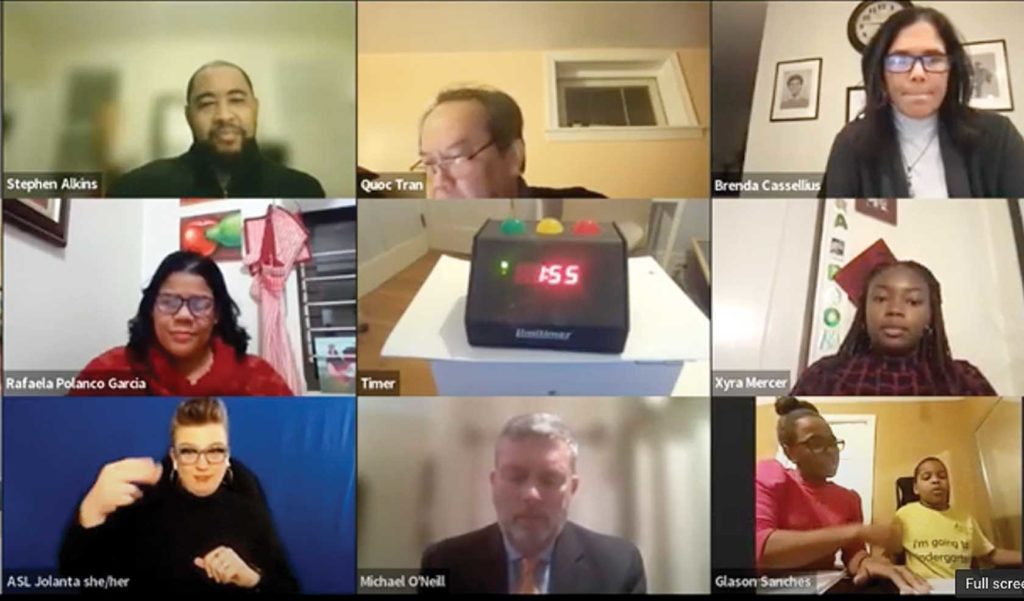Will BPS close the P.A. Shaw school?
Parents, staff appeal to School Committee

At last week’s Boston School Committee meeting, students and parents blasted Boston Public Schools for reversing a decision to extend the P. A. Shaw school to the fifth grade, with some expressing fears that the move will put their school’s future in jeopardy, as the majority of the district’s schools move toward a K-6 and 7-12 grade configurations.
Instead, the district has proposed closing one of the school’s two third-grade classrooms, citing declining enrollment at the school.
“Every year since this broken promise, we’ve faced declining enrollment and budget shortfalls,” testified parent Deb Shea. “Families with multiple children move younger students out of our school so that they can be with their older siblings who are now in a K-8. We’re in a situation not due to any fault of our students, families or educators, but as the direct result of decisions made without and in direct opposition to the input of the school community.”
While BPS officials say they have no current plans to close the school, the Shaw’s prospects don’t look good.
Shaw School supporters say their own push to transition the school to a K-6 grade configuration was aimed at keeping parents interested in enrolling their children at the school. Without such a shift, students from the Shaw, which now offers only K0 to grade 3, would have to transfer to a K-6, then move on to a 7-12 school. Such multiple transfers are widely seen as disruptive to students’ education. As other schools made the transition and the Shaw didn’t, however, fewer parents chose the school.
“We’ve seen a pretty consistent decline in enrollment,” said Shaw teacher Tracy Curtin. “We’ve had budget cuts every year since the decline.”
The Shaw is not the first school to experience the dynamic of forces beyond the school’s control driving downward enrollment and forcing budget cuts. Education advocates in Boston refer to it as the ‘death spiral.’ Most recently, the district’s middle schools fell prey to that spiral as the K-5 feeder schools that sent students their way transitioned to the K-6 model.
The McCormack Middle School in Dorchester was headed for the chopping block until staff and parents at the school proposed a merger with the Boston Community Leadership Academy, which was also seen by some as heading for the school department’s chopping block.
The school closures the district has enacted in recent years appear to be happening without a transparent plan. The only plan for buildings BPS has made public is its BuildBPS facilities plan, a 10-year roadmap the district launched in 2017 aimed at updating existing buildings and constructing new ones to provide students with what the district calls quality learning environments.
By 2027, the district aimed to have 12 buildings newly constructed or substantially renovated, according to a 2018 version of the plan. The plan makes no mention of closing existing buildings. Yet the district has in the last eight years closed 13 schools, citing factors ranging from declining enrollments to structurally unsafe buildings.
“It feels like the BuildBPS plan is really about closing schools and doing it slowly and in the most painful way,” said Ruby Reyes, executive director of the Boston Education Justice Alliance. “They’re identifying schools in areas that are mostly Black and Latino and have the highest number of school-age children, divesting them of their budgets year-after-year, then saying they don’t have enough students.”
Curtin, who teaches third grade at the Shaw, said the school community hopes the BuildBPS process will yield them a new building.
“The vision we have is for a K-6 full-inclusion school,” she said. “We fully support a new building in Mattapan for our students. We think that can happen without closing our school.”
Because Boston schools are funded on a per-pupil basis, as the schools lose students, heads of school are forced to make painful cuts. Librarians are fired and libraries shuttered. Arts and music programs are cut. The schools become even less appealing to parents.
The students are the ones who bear the brunt of the cuts, Reyes said.
“You have groups of students who get less and less every year,” Reyes said. “The district gets to say, ‘Nobody’s choosing your school.’ It becomes a major set-up for failure.”
At the Shaw, cuts have meant the school has lost an inclusion specialist who helped students with special needs. Now students with learning difficulties are forced to leave in K1. The school has also lost partnership money, forcing it to cut wraparound services for its students, including afterschool programs.
During the Jan. 26 School Committee meeting, members of the Shaw community received a ray of hope when Cassellius told them she wasn’t aware that district officials had in 2014 agreed to add a fourth and fifth grade at the school.
“This information was new to me,” Cassellius said.
If Cassellius supports the addition of the fifth grade, Shaw first-grader Glasson Sanders, for one, will likely push for more.
“We want a fourth, fifth and sixth grade at the Shaw,” he read from written testimony while his mother looked on. “And we are going to work together to make it happen so all our kids can keep learning in this community.”







